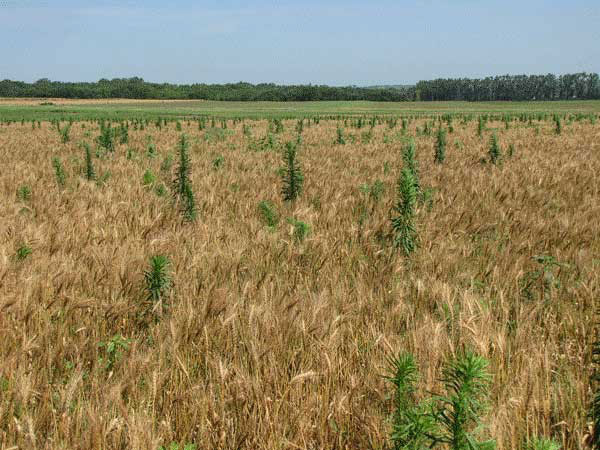Making a herbicide application that will not directly influence crop yield is a difficult decision to make. Such is the case with pre-harvest weed control applications to wheat fields. However, pre-harvest applications may be beneficial, especially in wheat fields with short or thin stands or fields that were not treated earlier in the season.
When broadleaf weeds grow rapidly at the end of the growing season, several potential concerns arise such as harvest difficulties, dockage problems, weed seed production, and soil water depletion. A pre-harvest herbicide application can address these concerns. However, it is very difficult to estimate the value of pre-harvest weed treatments as its more immediate potential benefits would be measured in terms of improved harvest efficiency and lower dockage. It may not pay to treat wheat with lower weed densities unless harvest is delayed.
Other potential benefits are longer-term. If the weeds are about to set seed, a pre-harvest treatment can go a long way toward reducing weed problems in future years by preventing seed production. Also, if weed densities are high, water depletion for subsequent crops could become significant unless the weeds are controlled prior to harvest.
Herbicides labeled for use as harvest aids in wheat are listed in Table 1. There are differences in how quickly they act to control the weeds, the interval requirement between application and grain harvest, and the level or length of control achieved. All of them will require thorough spray coverage to be most effective. Paraquat is sometimes mentioned as a possible herbicide for pre-harvest application but is not labeled for pre-harvest treatment in wheat. Application of paraquat to wheat is an illegal treatment and can result in a quarantine and destruction of the harvested grain, along with severe fines.

Figure 1. Weeds in wheat near harvest time. Photo by Dallas Peterson, K-State Research and Extension.
Table 1. Herbicides for use a pre-harvest weed control options in wheat.
|
Herbicide |
Weeds controlled |
Application timing |
PHI* (days) |
Comments |
|
Metsulfuron |
Some broadleaf weeds |
Hard dough stage |
10 |
Use 0.25 to 0.5 % v/v nonionic surfactant) |
|
2,4-D LVE |
Broadleaf weeds |
Hard dough stage |
14 |
Weak on kochia and wild buckwheat |
|
Dicamba |
Broadleaf weeds |
Hard dough stage and green color is gone from nodes |
7 |
Do not use treated wheat for seed unless a germination test results in 95% or greater seed germination. |
|
Glyphosate |
Grasses and broadleaf weeds |
Hard dough stage (30% or less grain moisture) |
7 |
Consult label for recommended adjuvants |
|
Carfentrazone (Aim EC, others) |
Pigweeds, kochia, lambsquarters, Russian thistle, wild buckwheat |
|
7 |
Use 1% v/v crop oil concentrate |
|
Saflufenacil (Sharpen) |
Broadleaf weeds |
Hard dough stage (30% or less grain moisture) |
3 |
Use 1% v/v methylated seed oil + 1 to 2% w/v AMS or 1.25-2.5% v/v UAN |
*PHI = Pre-harvest interval, or days required between application and harvest.
For more detailed information, see the “2022 Chemical Weed Control for Field Crops, Pastures, and Noncropland” guide available online at https://www.bookstore.ksre.ksu.edu/pubs/CHEMWEEDGUIDE.pdf or check with your local K-State Research and Extension office for a paper copy. The use of trade names is for clarity to readers and does not imply endorsement of a particular product, nor does exclusion imply non-approval. Always consult the herbicide label for the most current use requirements.
Sarah Lancaster, Weed Management Specialist
slancaster@ksu.edu
Tags: wheat weed control pre-harvest